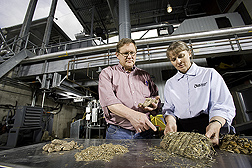USDA’s Agricultural Research Service is studying the use of plant residues for biofuels.
 At the University of Minnesota-Morris Biomass Gasification Facility, for example, gasification researcher Jim Barbour and ARS soil scientist Jane Johnson (pictured) are evaluating potential biomass feedstocks, including pressed corn stover.
At the University of Minnesota-Morris Biomass Gasification Facility, for example, gasification researcher Jim Barbour and ARS soil scientist Jane Johnson (pictured) are evaluating potential biomass feedstocks, including pressed corn stover.
The Agricultural Research Service has scientists in 18 states involved in the Renewable Energy Assessment Project (REAP) which is trying to determine the balance between how much crop residue can be used to produce ethanol and other biofuels and how much should be left on the ground to protect soil from erosion, maintain soil organisms, and store carbon in the soil.
Because corn is currently the most widely used biofuel crop, the REAP team is especially interested in determining where, when, and how much corn stover can be harvested without harming soil productivity. The work involves not only looking at how much plant residue is needed to maintain soil carbon than to control soil erosion, but also using perennial groundcover roots and shoots as alternative sources of organic material to offset the carbon lost when stover is removed.

